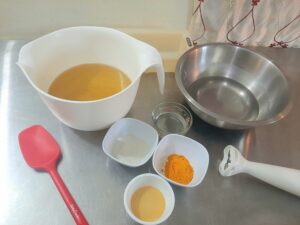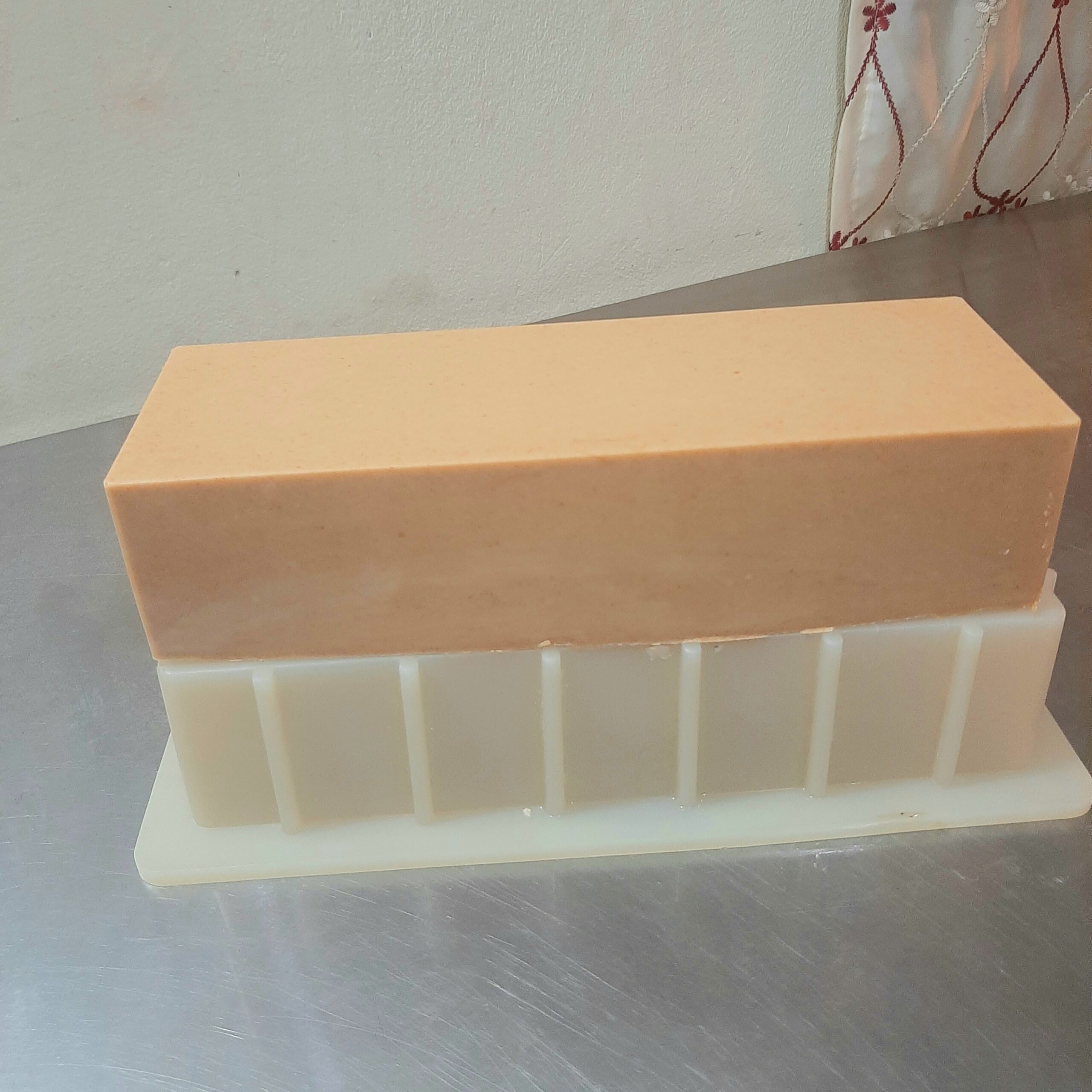Turmeric and honey are both known for their incredible benefits for the skin and have been used in beauty treatments for centuries.
In this post, I’ll be sharing a Turmeric and Honey cold process soap that is easy to make and can be customized with your choice of fragrance or essential oil, or left unscented.
This recipe also features the moisturizing goodness of shea and cocoa butter and the detoxifying power of bentonite clay, which helps to remove excess oil.
If you’re looking to brighten your complexion or keep acne at bay, this homemade soap is a true jewel in your skincare routine.
Benefits of Turmeric in Skincare
Making your own natural skincare products at home allows you to control the ingredients and avoid harsh, synthetic chemicals.
Turmeric or haldi as it is also called here in Trinidad and Tobago, has been an important ingredient in Ayurveda, a natural alternative system of medicine that originated in India over two millennia ago.
Turmeric is treasured for its anti-inflammatory and antioxidant properties and has been shown to be effective in treating skin conditions such as psoriasis, acne, eczema, dermatitis and hyperpigmentation. It may also have protective properties against sunlight and reduce the signs of skin ageing.

Benefits of Honey in Skincare
Honey, a natural humectant, contains minerals such as calcium, copper, iron, magnesium, manganese, phosphorus, potassium and zinc.
It is a good source of ascorbic acid (vitamin C) and pantothenic acid (vitamin b5), which help to moisturize the skin and improve its suppleness and appearance.
Honey also has antiseptic and antibacterial properties, which may be beneficial in fighting acne-causing bacteria.
It is believed that the Egyptian queen Cleopatra used honey in her ancient beauty rituals to keep her skin youthful and improve her complexion.

How to Make Cold Process Turmeric and Honey Soap
For this soap, I used local Trini honey from Seenath’s Pure Honey.

Tools
Sodium hydroxide reacts with metals such as aluminium, magnesium, zinc, tin, chromium, brass and bronze to produce hydrogen gas. Therefore, using non-reactive materials such as stainless steel or heavy-duty plastic is important when making soap.
- Safety goggles and gloves
- Stainless steel or heat-safe bowls
- Plastic containers
- Spatula
- Stainless steel spoons
- Non-reactive mixing bowl
- Glass or ceramic container (for fragrance/essential oil)
- Digital kitchen scale
- Immersion blender
- Soap mould
Ingredients
Oils and Butters
- 14 oz Coconut oil
- 12 oz Olive oil
- 2 oz Castor oil
- 2 oz Shea butter
- 2 oz Cocoa butter
Lye Solution
- 4.73 oz Sodium Hydroxide
- 12.16 oz Distilled water
Additives
- 0.5 oz Honey
- 0.35 oz Turmeric powder
- 0.35 oz Bentonite clay
- 1 oz Essential or Fragrance oil (optional)
Directions to Make Turmeric and Honey Soap
Safety first!!!
Ensure that you are working in a well-ventilated area. Wear gloves, long-sleeved clothing and safety goggles to protect your skin and eyes.
Prepare your workspace and gather the tools and ingredients needed.

First, weigh the water in a heat-resistant or stainless steel container.

Next, weigh the lye in a non-reactive container, such as plastic.

In a well-ventilated area, add the sodium hydroxide to the water (never the other way around) and carefully stir to dissolve completely. The dissolving solution will become hot and give off fumes. Avoid inhaling the fumes.

Once the lye is fully dissolved, set it aside in an area where it will not be disturbed and allow it to cool to room temperature.
Proceed to prepare the other ingredients.
Weigh the bentonite clay.

Weigh the turmeric powder.

Then, weigh the honey.

In a glass or ceramic container, weigh the essential or fragrance oil. Note that these oils can degrade plastic so a plastic container should not be used.
I used lavender essential oil in this soap.

Weigh the oils individually and add them to the mixing bowl.

Next, weigh the shea and cocoa butter in a heat-resistant or microwave-safe bowl.

Melt the butters in the microwave or use the double-boiler method. Be sure to heat the butter just enough to melt them – do not overheat.

Once fully melted, add the butters to the mixing bowl with the oils.

Now put away the unnecessary tools and ingredients and get ready to make the turmeric and honey soap.

Add the bentonite clay, turmeric and honey to the mixing bowl with the oils.

Using the immersion blender, mix them all together thoroughly.

Carefully add the lye solution to the mixing bowl, while simultaneously stirring with the immersion blender.

Using a mixture of pulsing and stirring with the immersion blender, continue to incorporate the ingredients together until the mixture reaches a light trace or a thin pudding-like consistency.

Add the essential or fragrance oil and blend to mix it in.

When the soap has reached a medium trace, pour it into your mould.
Tap the mould gently on a firm surface to remove any air bubbles and smooth or texture the top with a spatula, wooden skewer, or stainless steel spoon as you would like.

Remove From Mould and Cut Into Bars
Allow the soap to solidify for 24 to 48 hours, then remove from the mould and cut into bars.


Place the bars in a cool dry place for them to cure for a period of 4 to 6 weeks to complete the saponification process and allow excess water to evaporate from the soaps. Occasionally turn the bars to allow all sides to be exposed to the air.
After the curing period, lather up and enjoy your Turmeric and Honey soap.
Incorporating turmeric and honey into your skincare routine can work wonders for your complexion. This homemade soap not only harnesses the power of these natural ingredients from Mother Earth but also allows you to control what goes into your skincare products. Give this DIY project a try and enjoy the benefits of clear, healthy, and glowing skin.
Happy Soaping!! 🙂
Here are some of our other DIY turmeric recipes you may be interested in:





hai, saya suka resep ini karena bahkan di bagian bahan tambahan ada beratnya. anda tau kan betapa pemula sangat takut untuk menambahkan bubuk karena takut terlalu banyak atau terlalu sedikit. saya save dan pasti akan saya coba. terimakasih banyak
Terima kasih banyak atas komentarnya! Saya senang mendengar bahwa Anda merasa terbantu dengan rincian bahan. Semoga resepnya berjalan lancar, dan jangan ragu untuk berbagi hasilnya nanti! 🙂